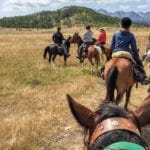At Atlas & Boots, we try to spend at least two weeks in any given country. Sadly, my recent horse riding trip in Montenegro was limited to just seven days. Given that I spent most of my time in the saddle, I had little interaction with the locals. Any chance I had was usually spent refusing second (and third) helpings of rakija, a colourless brandy of 40% alcohol!
I was keen to learn more about the country and thus set out to gather some interesting facts about Montenegro. Here’s the best of what I found.
Interesting facts about Montenegro
1. Montenegro is one of the newest countries in the world having declared its independence from Serbia on 3rd June 2006. Other than Serbia, only Kosovo (2008) and South Sudan (2011) are newer.
(Source: Washington Post)
2. Montenegro translates from Venetian Italian as ‘Black Mountain’. The name refers to Mount Lovćen which rises 1,749m (5,738ft) above sea level in southwestern Montenegro.
(Source: Britannica)
3. The Montenegrin coast boasts 117 beaches totalling a length of 52km (32mi).
(Source: Montenegro Tourism Board)

4. Montenegro is a tiny country (slightly smaller than Connecticut, USA) and has a population of only 643,000.
(Source: CIA World Factbook)
5. Montenegro is featured in the James Bond movie [easyazon_link keywords=”Casino Royale” locale=”US” tag=”atbo0c-20″]Casino Royale. Sadly, the scenes set in Montenegro were actually filmed in nearby Czech Republic. The country did play host, however, to a young Brad Pitt who filmed The Dark Side of the Sun there in 1987.
(Source: IMDb)
6. In terms of volume, Tara Canyon in Montenegro is Europe’s biggest canyon. It is 82km (51mi) in length, 1,300m (4,300ft) deep and 914m (3,000ft) at its widest point.
(Source: The Telegraph)

7. Montenegro’s top level domain is .me. After securing it in 2007, the government opened it up to world, marketing it as a generic top-level domain used to denote “Me”. It went live in 2008 and became the fastest-selling debut top level domain ever.
(Source: BBC)
8. Montenegro uses the euro as its de-facto currency. However, it has never had an official agreement with the EU and thus cannot mint, issue or print euro coins or notes itself.
(Source: European Commission, BBC)
9. The village of Crkvice on Mount Orjen in Montenegro is the wettest place in Europe with the highest total annual precipitation of 5,000mm.
(Source: The Soils of Serbia)

10. The village of Mitrovica in Montenegro is home to one of the oldest olive trees in the world. Stara Maslina is said to be over 2,000 years old!
(Source: Lonely Planet)
11. One of the most heartening interesting facts about Montenegro is that it’s one of the few countries in the world to include environmental protection in its constitution. It defines itself as a “civil, democratic, ecological” state.
(Source: FAO)
12. The mountains of Montenegro include some of the most rugged terrain in Europe, averaging more than 2,000m (7,000ft) in elevation. Bobotov Peak in the Durmitor Mountains is the country’s highest peak at 2,522m (8,274ft).
(Source: Britannica)

13. Montenegro was the first country in the world to have a national printing press.
(Source: Britannica)
14. Montenegrins are some of the tallest people in the world with an average male height of 1.832m (6ft). They rank second to the Dutch by only a fraction.
(Source: The Telegraph)
15. In some parts of the country, families still live by a centuries-old law called Krvna which recognises the right to vengeance; if a man from one family kills another, the family of the victim must respond in kind. This perhaps is one of less charming interesting facts about Montenegro…
(Source: VICE)
16. Sveti Stefan is one of the most iconic sites in Montenegro. The fortified island village is connected to the mainland by a narrow causeway. Sadly, the site is owned by a luxury resort making it off limits to all but paying guests.
(Source: Lonely Planet)

17. Montenegro is a diverse country in terms of ethnicity, language and religion with a mixture of Montenegrins, Serbs, Bosnians and Albanians practising Christianity, Islam and Catholicism.
(Source: CIA World Factbook)
18. Capital city Podgorica was all but destroyed by Allied bombing during the Second World War. It’s said that more massive damage was caused only to Pearl Harbor, Stalingrad and Dresden.
(Source: Montenegro: A Modern History)
19. Montenegro’s Biogradska Gora National Park is home to 1,600 hectares (16 sq km) of virgin woodland – one of Europe’s last three remaining primeval forests.
(Source: Lonely Planet)
Lonely Planet Montenegro is a comprehensive guide to Montenegro, ideal for those who want to both explore the top sights and take the road less travelled.










